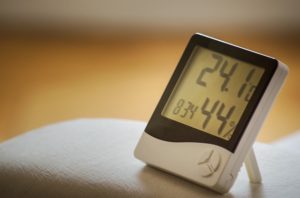Fundamentals of Indoor Humidity Control
With the weather getting cooler, you might be relieved to feel humidity levels outside dropping. But how much consideration have you given to humidity indoors? Make no mistake: home humidity control is essential. Not only is a proper indoor humidity crucial to your own health, but it also can help extend the life of your home and furnishings. Today, we’re laying out the fundamentals of home humidity control.

With the weather getting cooler, humidity levels are dropping. But how much consideration have you given to humidity indoors?
How to Measure Indoor Humidity
Let’s get this out of the way: the ideal indoor humidity level is between 30-50%. Your best bet may be to try to keep your home in the 45% zone.
But how do you measure indoor humidity? In Maryland or Virginia, it’s easy enough to tell when it’s humid outside versus when it’s dry outside. But it can be tough to get a gauge on the precise humidity percentage when conditions are not so extreme. But there are a few red flags you can look out for. One of these is condensation occurring on windows, or the buildup of mold on drywall. Either of these signs certainly indicate that your indoor humidity is too high. On the flip side, you may have noticed dried or cracking paint, or excessive levels of static electricity. These indicate the opposite—not enough humidity.
If you want more certainty, you could always invest in a hygrometer. This is a tool that will give you an exact read on indoor humidity percentage. The cheap ones will cost you less than 20 bucks.
My Humidity Level is Too High!
If your humidity levels are too high, you’re going to have to learn the basics of humidity control. Of course, dehumidifiers are a great way to draw moisture out of the air. You could also make some changes to your daily routine to reduce indoor humidity. This could include turning on your exhaust fan when cooking or bathing or opening windows (as long as it’s not even more humid outside). If the problem is in your bathroom, try taking shorter showers, and be sure to leave the bathroom door open when not in use.
If you’re addressing the problem too late and have already noticed mold in your home, be sure to look into mold remediation.
My Humidity Level is Too Low!
Perhaps your home has the opposite problem: your indoor humidity is too low. This is less likely to become an issue in our area, but it certainly happens. And its consequences can be serious; some germs and viruses thrive in lower humidity levels. It can also damage wood, paint, and even furniture. If you’ve been using a dehumidifier, be sure to turn it off. Once that’s done, the easiest solution is to use a humidifier.
There are also some more natural forms of humidity control, but these aren’t quite so effective. Some people have had success by leaving vessels full of water near a heat source, such as a radiator or fire. If you have a drying rack, you could also use that instead of a drier. Not only is this a greener way to dry your clothes, but it can also help to increase indoor humidity in a pinch.
Contact All Aspects Waterproofing Today for Your Humidity Control Needs
Whether you need a new sump pump installed or want to waterproof your entire basement, contact All Aspect Waterproofing, a Better Business Bureau A+ rated company with over 30 years of experience in the Washington, DC./Maryland/Virginia area. We have a great deal of experience in waterproofing, mold testing, and mold remediation, and we want to make you feel at home again. Contact us online or by calling 1-866-999-3110 or 301-766-4420. To see what we’re up to, follow us on Facebook, Twitter, Pinterest, YouTube, LinkedIn, and Houzz.
